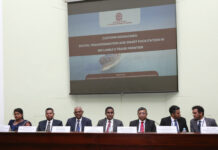Did you know that globally women amount to only about a quarter of the workforce in Science, Technology, Engineering, and Math (STEM), and that men vastly outnumber women majoring in most STEM fields in universities? The gender gaps are particularly high in some of the fastest-growing and highest-paid jobs such as IT and engineering.
How serious is the underrepresentation of women in STEM in Sri Lanka? According to the University Grants Commission (UGC), in 2017, women accounted for nearly half – 49 percent – of undergraduate enrolments in STEM subjects in local universities. And yet, when examining the workforce, there are far fewer women working and leading in STEM. There is also a significant gendered divide within different STEM sectors, with much lower representation of women in fields like math, engineering and technology which are seen as ‘masculine’ or ‘male oriented’ fields, while more women in STEM pursue care-oriented fields such as health and biological sciences.
Why are there fewer women in STEM fields?
The underrepresentation of women in STEM is shaped by harmful gender stereotypes, norms and roles. These range from the idea that investment in women’s education is less important since women are primarily caregivers while men are breadwinners, to the belief that certain STEM fields are naturally more suited to the ‘male/ masculine’ mind and that women cannot equally understand or thrive in them. These biases and norms affect men and women in these sectors. Women often choose their fields of education and work based on how they perceive their abilities and roles in society. Men – particularly male family members, educators, and employers – allow these norms to guide their support, teaching, and recruitment. These are major challenges to women’s equal entry into and engagement in STEM careers.
In Sri Lanka, the multilayered crisis threatens to widen the gender gap in STEM fields. Building off of harmful gender norms and biases, economic hardship has affected girls’ access to education, with families choosing to educate their sons instead of daughters to cope with rising costs and poverty.
Why do we need more women in STEM?
As Sri Lanka navigates this economic crisis, addressing the gender gap in STEM fields is more crucial than ever. With an increasing number of jobs being digitalized, it is essential that women are not left behind in this transition and contribute to the development of a more equal and sustainable future economy. Women in Sri Lanka’s workforce predominantly belong to the low-skilled and informal workforce, and continue to be a minority in sectors like the tech industry, for example, which is one of the fastest-growing and highest-paying sectors worldwide. Closing the gender gap in STEM will ensure that women have access to more high-skilled employment and are meaningfully included in the economic growth that is driven by technology and innovation.
At the same time, as these fields evolve and expand, it is increasingly imperative that the capabilities and perspectives of women are brought in to bring about innovative inclusive, and effective solutions to the complex societal challenges of today and to strengthen our collective performance on economic and development indicators. During the COVID-19 pandemic, for example, it was largely women in medical research who led the development of vaccines while also studying gendered impacts of COVID-19 on women’s bodies – a nuance which is too often excluded from scientific study. In a time of growing online violence, women in tech are leading the advocacy and work on developing safeguards and accountability systems to protect female users. As work on artificial intelligence (AI) expands, the technical contribution and oversight of women is vital to combat gender biases in AI algorithms.
We cannot have products and innovation which include and reach out to all communities, genders, and consumer groups, unless they are equally driven by women.
What are the necessary steps to close the gender gap in STEM in Sri Lanka?
Closing the gender gap in STEM in Sri Lanka will require targeted and continued efforts in society, institutions, and the operational frameworks of STEM fields.
As global societies, we must deconstruct harmful gender stereotypes and biases on the roles of women in society and their capacity to thrive in and expand STEM fields. But what does that mean?
It means holistic efforts to recognize our own individual assumptions and biases about each gender, and to address them in our daily life. It means reforming our educational structures and approaches. Our schools and universities must allow and encourage students to explore their interests regardless of their gender, and expand from current approaches to – for example – encourage boys to explore domestic skills and the arts, and girls to explore mechanics and high-intensity sport. Our educational structures must celebrate those who have crossed gender lines, and pave the path for innovators, scientists, and artistes alike. Curricula across all levels of education must build an understanding of social issues along with critical thinking skills to recognize and deconstruct biases and discrimination. Academics must increasingly examine issues of science, technology, engineering and math through the lens of gender, in line with growing research that makes vital discoveries when adopting sex and gender disaggregated analysis.
It means reforming the approach of media and the arts to present a broader view of individual capabilities, character, and potential, and counter discriminatory and misogynistic views, rather than reinforcing restrictive and biased gender norms.
It means breaking the barriers that keep and push women out of the STEM workforce and making tangible reforms towards more inclusive workplaces that allow women to thrive and lead in STEM. If the gender gap in STEM fields is to be sustainably redressed, our efforts must go beyond performative policies and translate into structural and equitable change including equal pay for equal work, equal paid family leave, childcare facilities and flexible work arrangements. These shifts in companies’ operating ethos have a tangible impact on closing gender gaps and retaining talent and skilled labour – a fact which has been established by multiple global and regional studies. The necessity of attracting and retaining women in STEM is increasingly recognized by leading actors in these fields. Giants in the technology sector including Google and Microsoft have programmes targeting the recruitment and upskilling of women in tech. In some instances, international corporates, tech hubs, and governments have created collectives for more diverse and inclusive landscapes in technology.
The future of STEM must belong to all of us. By closing the gender gap in STEM fields, we not only empower women and girls, but we also unleash a wealth of creativity and innovation as well as necessary inclusion and progress for society as a whole. It’s time to take action and break down the barriers that limit women’s contributions in STEM fields. On this year’s International Day of Women and Girls in Science let’s work together, challenge biases, and pave the way for a brighter and more equal future in the fields of science and innovation – for all.












